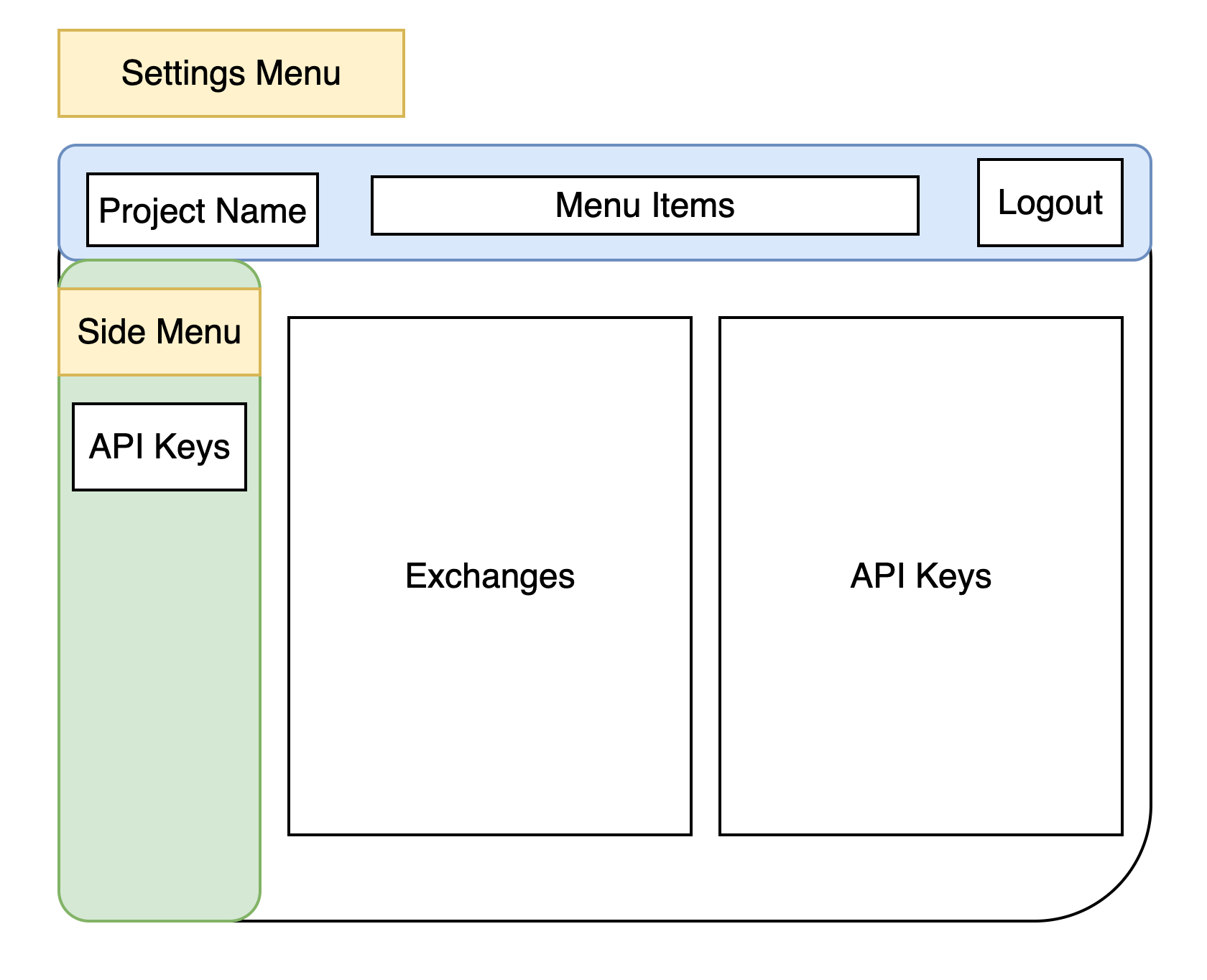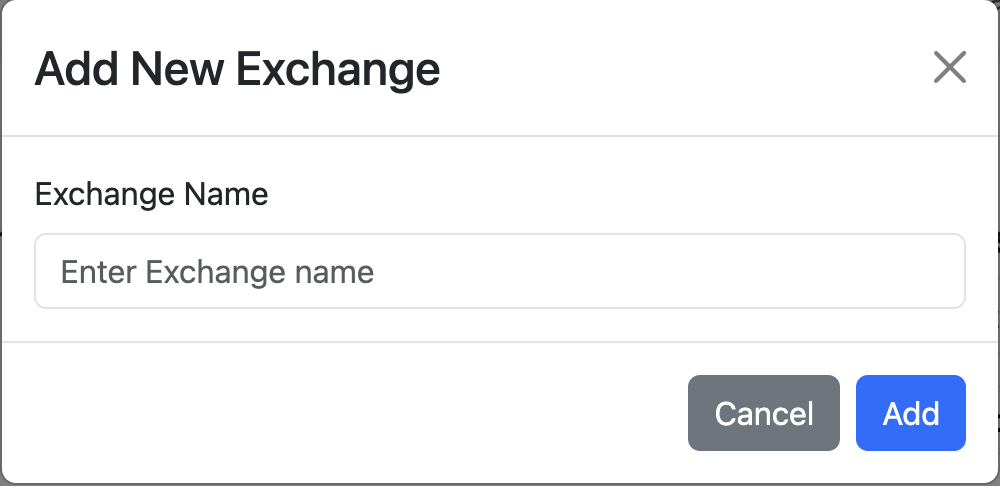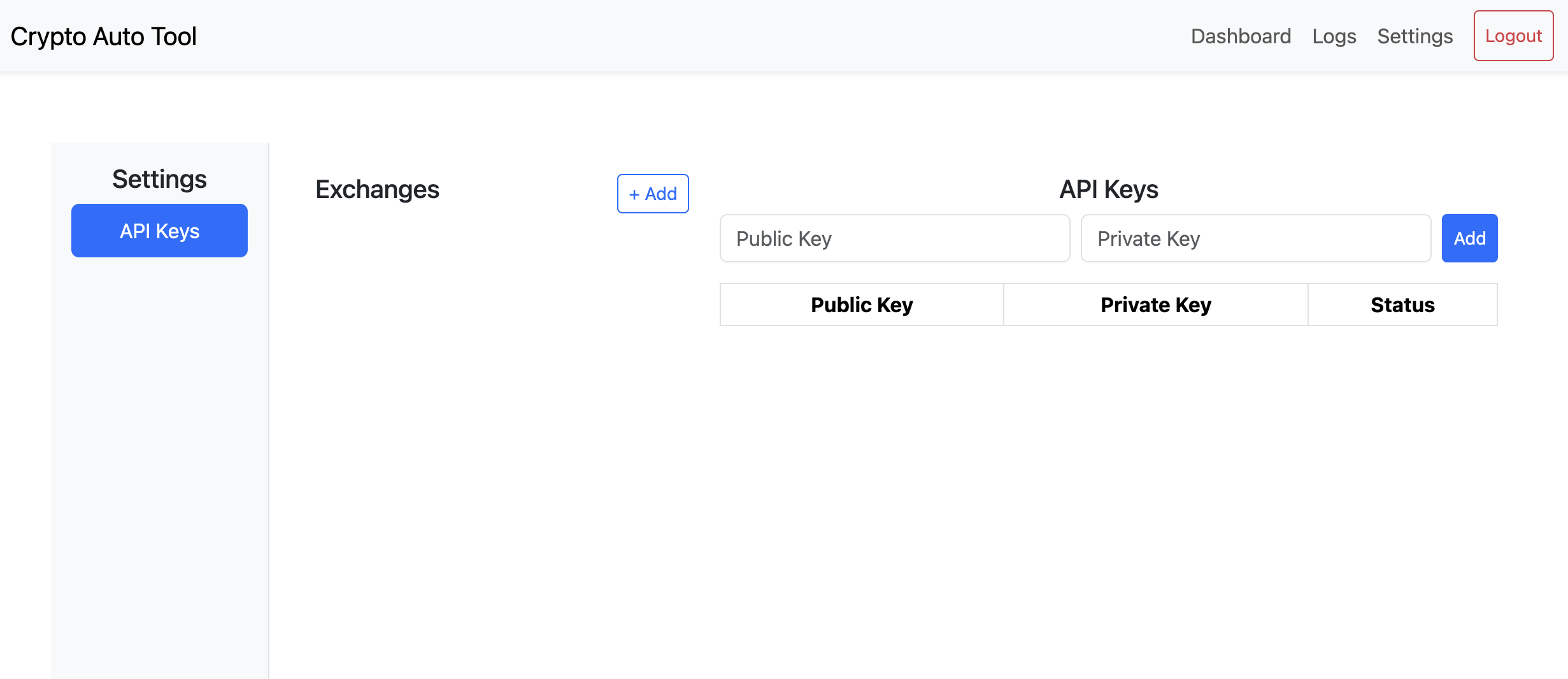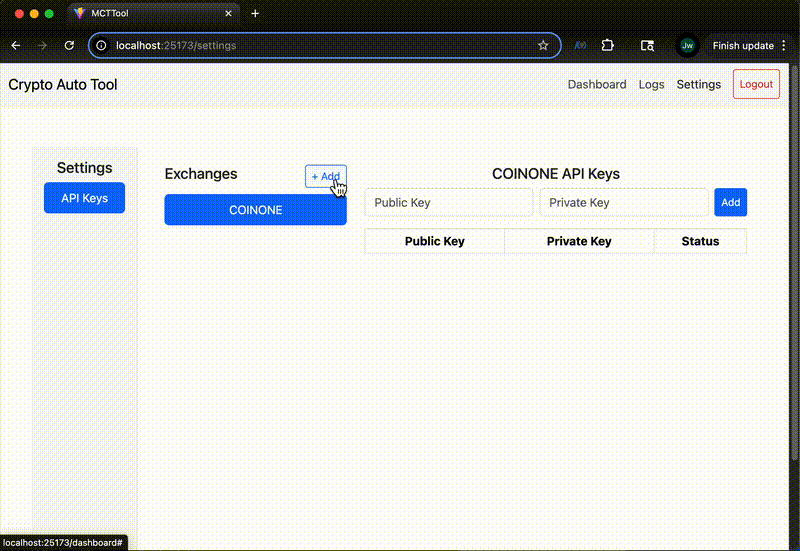11. Managing API Keys - Frontend Implementation
This post outlines the frontend design and implementation for API key management.
1. The design of the API Key Management
1.1 API Key Management Structure
-
To visualize the layout, I sketched a simple diagram of the API Key management page.
-
Left-side Menu Items: Under Settings, several submenus are available.
-
Exchanges: Area for managing exchanges.
-
API Keys: Area for managing API keys.
The sidebar stays fixed on the left, and the content area renders on the right.
2. Frontend
2.1 SettingsSideBar.tsx
-
This component renders the sidebar menu.
-
The menu currently includes an API Keys item for navigating to the key-management view.
-
Clicking a menu item renders the corresponding content.
import { ListGroup } from "react-bootstrap"; type SettingsSidebarProps = { selected: string; onSelect: (key: string) => void; }; const SettingsSidebar = ({ selected, onSelect }: SettingsSidebarProps) => { return ( <div className="bg-light vh-100 border-end p-3"> <h5>Settings</h5> <ListGroup> <ListGroup.Item active={selected === "API Keys"} onClick={() => onSelect("API Keys")} style={({ cursor: "pointer" })} >API Keys</ListGroup.Item> </ListGroup> </div> ) } export default SettingsSidebar;
2.2 ExchangeList.tsx
-
This component displays the list of exchanges returned by the backend.
-
A + Add button creates a new exchange. Deletion will be added later.
import { ListGroup, Button } from "react-bootstrap"; type ExchangeListProps = { exchanges: { exchange_id: number; exchange_name: string }[]; selectedExchange: string; onSelectExchange: (exchange: { exchange_id: number; exchange_name: string }) => void; onAddExchange?: () => void; }; const ExchangeList = ({ exchanges, selectedExchange, onSelectExchange, onAddExchange }: ExchangeListProps) => { return ( <div> <div className="d-flex justify-content-between align-items-center mb-2"> <h5>Exchanges</h5> <Button variant="outline-primary" size="sm" onClick={onAddExchange}>+ Add</Button> </div> <ListGroup> {exchanges.map((ex) => ( <ListGroup.Item key={ex.exchange_id} active={ex.exchange_name === selectedExchange} onClick={() => onSelectExchange(ex)} style={{ cursor: "pointer" }} > {ex.exchange_name} </ListGroup.Item> ))} </ListGroup> </div> ); }; export default ExchangeList;
2.3 AddExchangeModal.tsx
-
This modal allows users to add a new exchange.
-
It presents a single input for the exchange name and two actions: Cancel and Add.
import { Modal, Button, Form } from "react-bootstrap"; interface AddExchangeModalProps { show: boolean; onHide: () => void; exchangeName: string; onExchangeNameChange: (value: string) => void; onAddExchange: () => void; } const AddExchangeModal = ({ show, onHide, exchangeName, onExchangeNameChange, onAddExchange, }: AddExchangeModalProps) => { return ( <Modal show={show} onHide={onHide}> <Modal.Header closeButton> <Modal.Title>Add New Exchange</Modal.Title> </Modal.Header> <Modal.Body> <Form> <Form.Group> <Form.Label>Exchange Name</Form.Label> <Form.Control type="text" value={exchangeName} onChange={(e) => onExchangeNameChange(e.target.value)} placeholder="Enter Exchange name" /> </Form.Group> </Form> </Modal.Body> <Modal.Footer> <Button variant="secondary" onClick={onHide}>Cancel</Button> <Button variant="primary" onClick={onAddExchange}>Add</Button> </Modal.Footer> </Modal> ); }; export default AddExchangeModal;
2.4 ApiKeyManager.tsx
-
This component sends a POST request to the backend to add API keys.
-
It expects an
access_tokento be stored inlocalStorage. -
When the component receives the API key list, it displays it in a table.
import { Table, Button, Form } from "react-bootstrap"; import { useState } from "react"; import api from "@/services/axios"; function getUserNoFromToken(): number | null { const token = localStorage.getItem("access_token"); if (!token) return null; try { const payload = JSON.parse(atob(token.split(".")[1])); return payload.user_no || null; } catch (err) { console.error("Failed to decode JWT:", err); return null; } } type ApiKey = { public_key_masked: string; private_key_masked: string; update_date: string; is_active: boolean; }; type ApiKeyManagerProps = { exchange: { exchange_id: number; exchange_name: string } | null; apiKeys: ApiKey[]; onRefresh: () => void; }; const ApiKeyManager = ({ exchange, apiKeys, onRefresh }: ApiKeyManagerProps) => { const [publicKey, setPublicKey] = useState(""); const [privateKey, setPrivateKey] = useState(""); const handleAddKey = async () => { const userNo = getUserNoFromToken(); if (!exchange || !userNo || !publicKey || !privateKey) return; try { await api.post("/api/settings/exchange-api-key", { user_no: userNo, exchange_id: exchange.exchange_id, public_key: publicKey, private_key: privateKey }); setPublicKey(""); setPrivateKey(""); onRefresh(); } catch (err) { console.error("Failed to add API key:", err); } }; return ( <div> <div className="mb-3"> <h5>{exchange?.exchange_name} API Keys</h5> <Form className="d-flex gap-2 mb-2"> <Form.Control type="text" placeholder="Public Key" value={publicKey} onChange={(e) => setPublicKey(e.target.value)} /> <Form.Control type="password" placeholder="Private Key" value={privateKey} onChange={(e) => setPrivateKey(e.target.value)} /> <Button variant="primary" size="sm" onClick={handleAddKey}> Add </Button> </Form> </div> <Table striped bordered hover size="sm"> <thead> <tr> <th>Public Key</th> <th>Private Key</th> <th>Status</th> </tr> </thead> <tbody> {apiKeys.map((key, idx) => ( <tr key={idx}> <td>{key.public_key_masked}</td> <td>{key.private_key_masked}</td> <td> <span style={{ display: "inline-block", width: "10px", height: "10px", borderRadius: "50%", backgroundColor: key.is_active ? "green" : "red" }} ></span> </td> </tr> ))} </tbody> </Table> </div> ); }; export default ApiKeyManager;
2.5 DynamicLogTable.tsx
-
This component renders a generic table from a list of objects.
-
If the list contains date-time fields, it formats them using the
ko-KRlocale and theAsia/Seoultimezone. -
Boolean values are shown as Y/N, and
null/undefinedvalues render as empty cells.import { Table } from "react-bootstrap"; type DynamicLogTableProps = { title: string; data: Record<string, unknown>[]; }; const DynamicLogTable = ({ title, data }: DynamicLogTableProps) => { if (!data || data.length === 0) { return <p>No data available.</p>; } const headers = Object.keys(data[0]); return ( <> <h4>{title}</h4> <Table striped bordered hover responsive> <thead> <tr> {headers.map((key) => ( <th key={key}>{key}</th> ))} </tr> </thead> <tbody> {data.map((item, idx) => ( <tr key={idx}> {headers.map((key) => ( <td key={key}> {item[key] == null ? "" : item[key] === true ? "Y" : item[key] === false ? "N" : typeof item[key] === "string" && /^\d{4}-\d{2}-\d{2}T\d{2}:\d{2}:\d{2}.*Z$/.test(item[key] as string) ? new Intl.DateTimeFormat("ko-KR", { year: "numeric", month: "2-digit", day: "2-digit", hour: "2-digit", minute: "2-digit", second: "2-digit", hour12: false, timeZone: "Asia/Seoul", }).format(new Date(item[key] as string)) : String(item[key])} </td> ))} </tr> ))} </tbody> </Table> </> ); }; export default DynamicLogTable;
2.6 Settings.tsx
- This page renders the Settings view.
- What this page does
-
Renders the Settings sidebar on the left and the content area on the right.
-
When the API Keys tab is active, it loads the exchange list, selects the first exchange by default, and fetches that exchange’s API keys.
-
Show two panels side by side: Exchanges (left) and API Keys (right).
-
Opens a modal to create a new exchange and refreshes the list after creation.
-
For other tabs (to be added later), displays a paginated log table.
import { useState, useEffect } from "react"; import { Container, Row, Col, Pagination } from "react-bootstrap"; import SettingsSidebar from "@/components/SettingsSideBar"; import DynamicLogTable from "@/components/DynamicLogTable"; import api from "@/services/axios"; import ExchangeList from "@/components/ExchangeList"; import ApiKeyManager from "@/components/ApiKeyManager"; import AddExchangeModal from "@/components/AddExchangeModal"; const Settings = () => { const [selectedLog, setSelectedLog] = useState("API Keys"); interface Exchange { exchange_id: number; exchange_name: string; } interface LogEntry { [key: string]: string | number | boolean | null; } const [logDataMap, setLogDataMap] = useState<Record<string, LogEntry[]>>({}); const [pageMap, setPageMap] = useState<Record<string, number>>({ "API Keys": 1 }); const itemsPerPage = 10; const [exchangeList, setExchangeList] = useState<Exchange[]>([]); const [selectedExchange, setSelectedExchange] = useState<Exchange | null>(null); interface MaskedApiKey { public_key_masked: string; private_key_masked: string; update_date: string; is_active: boolean; } const [apiKeyMap, setApiKeyMap] = useState<Record<string, MaskedApiKey[]>>({}); const [showExchangeModal, setShowExchangeModal] = useState(false); const [newExchangeName, setNewExchangeName] = useState(""); useEffect(() => { if (selectedLog === "API Keys") { api.get("/api/settings/exchanges").then((res) => { setExchangeList(res.data); if (res.data.length > 0) { const defaultExchange = res.data[0]; setSelectedExchange(defaultExchange); fetchApiKeys(defaultExchange.exchange_name); } }); } }, [selectedLog]); const fetchApiKeys = (exchange: string) => { const token = localStorage.getItem("access_token"); if (!token) return; try { const payload = JSON.parse(atob(token.split(".")[1])); const user_no = payload.user_no; api .get(`/api/settings/exchange-api-key`, { params: { user_no }, }) .then((res) => { setApiKeyMap((prev) => ({ ...prev, [exchange]: res.data })); console.log(res); }); } catch (e) { console.error("Failed to decode token or fetch API keys:", e); } }; useEffect(() => { if (!logDataMap[selectedLog]) { const endpoint = selectedLog === "API Keys" ? "/api/settings/exchanges" : ""; if (endpoint) { api.get(endpoint).then((res) => { setLogDataMap((prev) => ({ ...prev, [selectedLog]: res.data })); setPageMap((prev) => ({ ...prev, [selectedLog]: 1 })); }); } } }, [selectedLog, logDataMap]); const currentPage = pageMap[selectedLog] || 1; const allData = logDataMap[selectedLog] || []; const indexOfLastItem = currentPage * itemsPerPage; const indexOfFirstItem = indexOfLastItem - itemsPerPage; const currentData = allData.slice(indexOfFirstItem, indexOfLastItem); const handleAddExchange = async () => { if (!newExchangeName.trim()) return; try { await api.post("/api/settings/exchanges", { exchange_name: newExchangeName }); const res = await api.get("/api/settings/exchanges"); setExchangeList(res.data); setNewExchangeName(""); setShowExchangeModal(false); } catch (err) { console.error("Failed to add exchange: ", err); } } return ( <Container fluid> <Row> <Col md={2}> <SettingsSidebar selected={selectedLog} onSelect={setSelectedLog} /> </Col> <Col md={10} className="p-4"> {selectedLog === "API Keys" ? ( <Row> <Col md={4}> <ExchangeList exchanges={exchangeList} selectedExchange={selectedExchange?.exchange_name || ""} onSelectExchange={(ex: Exchange) => { setSelectedExchange((ex)); fetchApiKeys(ex.exchange_name); }} onAddExchange={() => setShowExchangeModal(true)} /> </Col> <Col md={8}> <ApiKeyManager exchange={selectedExchange || { exchange_id: 0, exchange_name: "" }} apiKeys={selectedExchange ? apiKeyMap[selectedExchange.exchange_name] || [] : []} onRefresh={() => { if (selectedExchange) fetchApiKeys(selectedExchange.exchange_name); }} /> </Col> </Row> ) : ( <> <DynamicLogTable title={`${selectedLog} Logs`} data={currentData} /> {allData.length > itemsPerPage && ( <Pagination className="justify-content-center mt-4"> {Array.from({ length: Math.ceil(allData.length / itemsPerPage) }, (_, i) => ( <Pagination.Item key={i + 1} active={i + 1 === currentPage} onClick={() => setPageMap((prev) => ({ ...prev, [selectedLog]: i + 1 })) } > {i + 1} </Pagination.Item> ))} </Pagination> )} </> )} </Col> </Row> <AddExchangeModal show={showExchangeModal} onHide={() => setShowExchangeModal(false)} exchangeName={newExchangeName} onExchangeNameChange={setNewExchangeName} onAddExchange={handleAddExchange} /> </Container> ); }; export default Settings;
-





